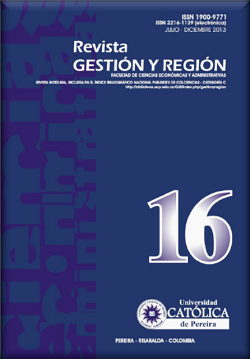Moral hazard in the general social security system in Colombian health, in 2011
Keywords:
moral hazard, ex ante moral hazard, ex post moral hazard, general socialsecurity health affiliate schemesAbstract
This paper presents the analysis of the results and findings of the study related to theexistence of moral hazard in the general social security system Colombian health (SHSS).The aim of the study was to identify the existence of moral hazard in their ex ante and ex postmanifestations.Gertler et al's model was implemented (1987; Applied by Santa Maria et al, 2009), for thecorresponding estimates.Joining a health system increases the probability of medical consultation for prevention (exante moral hazard). Also, when it has additional health programs, the probability ofconsulting for reasons of prevention. Likewise, securing the SHSS (contributory scheme, forexample) generates ex post moral hazard directly: coverage increases the probability ofchoosing medical visits or contact your health care provider.When the contributory scheme they belong increases the probability of using health services3.4% (dependent variable being a doctor depending on the variable in health care spending).A sign of the presence of ex post moral hazard is related to the value to pay for health careservices: a lower value to pay, more likely to see a doctor or health care institution.
References
Andersen, Ronald (1968), Behavioral model offamilies' use ofhealth services, Chicago, IL: Center for Health Adrnínistration Studies-University of Chicago Press, Research Series No 25. Citado en: Clavero y González (2005).
Andersen, Ronald (1995), "Revisiting the behavioral m o del and access to medical care: does it matter?", Journal ofHealth and Social Behavior, 36: 1-1O. Citado en: Clavero y González (2005).
Arrow, Joseph (1963). “Uncertainty and the welfare economics of medical care”, American Economics Review, 53, pp. 941-973.
Barahona, Planck (2010). “El efecto del copago en el sistema sanitario: ¿existencia de problemas de equidad?”. Revista de ciencias sociales Prisma Social, n°4.
Chicaíza, Liliana; Rodríguez, Fredy y García, Mario (2006). La equidad del mecanismo de pago por uso de servicios en el sistema de aseguramiento en salud de Colombia. Revista Economía Institucional.; vol. 8, n°15. Bogotá.
Clavero, Antonio y González María (2005). Una revisión de modelos econométricos aplicados al análisis de demanda y utilización de servicios sanitarios. Universidad de Málaga.
Ellis, Randall y McGuire, Thomas (1993). “Supply- Side and Demand-Side Cost Sharing Health Care, 7- 4, pp. 135-151. Journal of economics Perspectives Citado en: Barahona (2010).
García, Manuel (2004). El Ajuste de Riesgos en el Mercado Sanitario. XXIV Jornadas de Economía de la Salud. Universidad Carlos III Madrid. Consultado en: www.fgcasal.org/aes/docs/Ajustede .pdf
Gertel, Paul (1987). “Are User Fees Regresive? The Welfare Implications of Health Care Financing Proposal in Peru”, (North-Holland, Ed.) Journal of Econometrics , et al Vol. 36, pp. 67-88. Citado en: Santa María (2009).
Grossman, Michael 1972a), The demandfor health: a theoretícal and empírica! ínvestigation, New York: National Bureau of Economic Research, Columbia University Press. Citado en: Clavero y González (2005).
Grossman, Michael (1972b), "On the concept ofhealth capital and the demand for health", Journal ofPolítica Economy, 80: 223-255. Citado en: Clavero y González (2005).
Jensen, Michael and Meckling, William 1976): Theory of the firm: Managerial (behavior, agency coast and ownership structure. Rochester University (NY). Consultado en: www.sfu.ca/~wainwrig/.../ -eckling.pdf
Manning, Willard et al. (1987). Health Insurance and the Demand for Medical Care: Evidence from a Randomized Experiment. Consultado en: www.rand.org/pubs/reports/2005/R3476.pdf. Consultado en: www.rand.org/content/dam/rand/pubs/.../R3476.pdf: Citado en: Clavero y González (2005).
Rosen, Harvey (1995). “Social Insurance II: Health Care”. En Public Finance. 4ª edición, editado por Harvey Rosen, pp. 224-40. New Cork: McGraw-Hill. Citado en: Barahona (2010).
Santa María, Mauricio; García, Fabián y Vásquez, Tatiana (2009). El sector salud en Colombia. Riesgo moral y selección adversa en el sistema general de seguridad social en salud. Coyuntura económica. Fedesarrollo; volumen XXXIX, Número 1.
Tono, Teresa (2008). Afiliación, pago y recaudo de aportes al sistema general de social en salud. Ministerios de Protección Social (MPS, 2008). Programa de apoyo a la reforma en salud PARS.
Zweifel, Peter y Breyer, Freiedrich (1997). Health Economics. Oxford University press.

